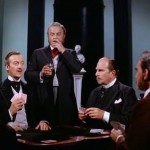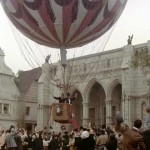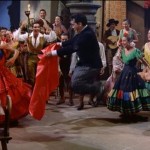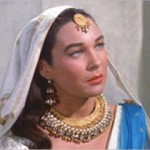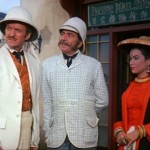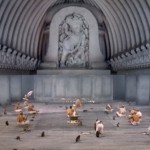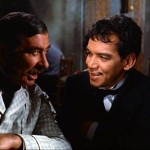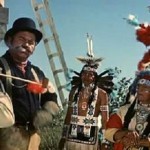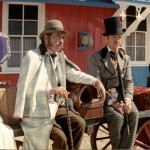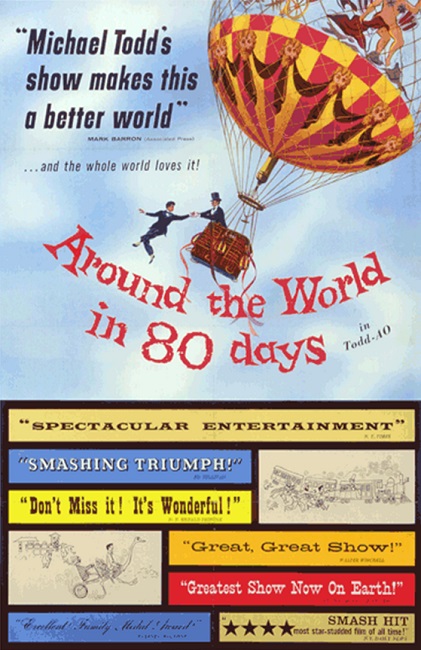
Around the World in 80 Days – 1956
This movie was wonderful for several reasons. First – It was in color! And I think we have finally made it past black & white. As far as I know, the next black & white film to win Best Picture is The Artist in 2011. Next, the actors did a fantastic job creating memorable characters. The score was written in a grand style befitting the epic journey that takes place in the film. And all this is applied to one of Jules Vern’s most beloved classic novels. I have actually read and enjoyed this book.
Location, location, location!! As you might imagine, this movie goes around the world and offers somewhat of a travelogue, showing us all the foreign locations through which the characters travel. We get to visit London, Spain, India, Thailand, Japan, The United States, and of course, all the oceans in between. Of course, the story takes place in 1872, so much of what was shown had to be dated to that time period. The lucky cast and crew filmed most of the movie on location so they all got to visit all of the exotic places.
Let’s start off with the cast. David Niven did a fine job as the quintessential Proper English Gentleman, Phileas Fogg. He was always serious, to the point, punctual, strict, and had little patience for even the smallest deviations from his plans. He is always in control of himself, even if he cannot control the world around him. His character followed the book very closely, except for one point. In the book, he loses control of his emotions at the end, even going so far as to punch Inspector Fix for making him lose his bet.
Interesting note: David Niven was very eager to play the role of Phileas Fogg, so much so that when asked to do it, he exclaimed that he would do it for free. He later commented that he was glad they did not take him up on that offer.
Playing opposite Niven was a Mexican actor and comedian named Cantinflas, playing the part of Fogg’s manservant, Passepartout. In contrast to Fogg, Passepartout is the comic relief of the film. He is a Jack-of-all-Trades with an eye for the ladies, which sometimes leads him into trouble. In the book he was a Frenchman, but because they were able to get such a big name comedian to play the part, they changed the character to be Latin.
Now, here is the trick with the casting of those two parts: David Niven was a well-known actor, but apparently, Cantinflas was an even bigger name on the world-wide level. This was a little backwards because Fogg is the main character of the film, but because Cantinflas was better known, the posters and advertisements for the film in most countries around the world gave him top billing, as if his character was the focus of the film. In fact, Charlie Chaplin even called Cantinflas “the world’s greatest clown.” Of course, today, I think more people remember Niven.
Princess Aouda, the lovely Indian girl, was played by a very young Shirley MacLaine. She didn’t really do much in the film except follow Fogg on his travels, but that’s alright. Her character also remained pretty true to the book. And finally, we have Robert Newton playing the part of the determined Inspector Fix. He follows Fogg all around the globe, trying to arrest him for a crime he didn’t commit. Again, pretty true to the book.
As a matter of fact, the entire movie was very faithful to the book, so in that respect I was rather impressed. There were only two minor differences and both were easy to forgive. One was that at the start of Fogg’s journey, he flew over the Alps in a hot-air balloon. That was not in Vern’s novel. Second was a sequence in which Passepartout does some comedic bull-fighting to help him and his master acquire passage on a ship. This was also not in the book, but it was put in the film to give more screen time to Cantinflas, who had actually done some bull-fighting in the past.
Interesting note: This movie used a ton of cameo appearances. There were around 48 in all. Some of the bigger names were Charles Boyer, Cesar Romero, Reginald Denny, Peter Lorre, Red Skelton, Marlene Dietrich, Frank Sinatra, Buster Keaton, and John Gielgud.
As I already mentioned, this was filmed in color. The movie would not have been as good if it had been black & white. This was important because of all the varied and exotic locations: The blues and greens of the sky and the far landscapes during the balloon ride over the Alps. The beautiful red and gold costumes of the matadors in Madrid. The vibrant reds and oranges of sunsets over the seas off the coast of Bombay. The dark greens of the jungles on the road to Calcutta. The bright and colorful robes of the geishas in Yokohama. The striking pinks and purples of the stockings worn by the dancing girls in San Francisco. The film really made great use of color to catch the attention of the audience.
That being said, I do have one little complaint. Everywhere they went the extras were all dressed in the traditional costumes of the region. While such clothing is generally bright and fancy, I doubt that people really wear it every day. In that respect, I thought it was a bit too “Hollywood” – almost a little fake. But I can understand why they did it for several reasons. First, it was a clear indication to let the audience know where the characters were. If you see the women on the screen all wearing rainbow colored saris, you know they have made it to India. Second, it gave the filmmakers the opportunity to show off bright colors on the screen, while the majority of the industry was still producing black & white movies. And third, I think the audiences of 1956 were more interested in seeing glamorous fantasy than the drab squalor of reality, a sentiment that seems to have changed for audiences of today.
This was a very memorable film that won five of the eight Academy Awards it was nominated for. As you might expect it also took home the Oscar for Best Cinematography, but also Best Adapted Screenplay, Best Music Scoring, and Best Film Editing. At its core, the story is just a fun story. It is a great and grand adventure that takes the audience to different and exciting places. Great book, great characters, great locations, and great plot. Great movie.
